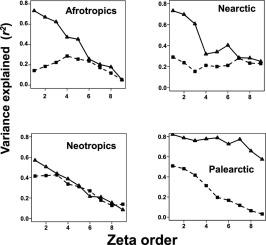当前位置:
X-MOL 学术
›
Int. J. Parasitol.
›
论文详情
Our official English website, www.x-mol.net, welcomes your
feedback! (Note: you will need to create a separate account there.)
Drivers of compositional turnover are related to species' commonness in flea assemblages from four biogeographic realms: zeta diversity and multi-site generalised dissimilarity modelling.
International Journal for Parasitology ( IF 3.7 ) Pub Date : 2020-03-26 , DOI: 10.1016/j.ijpara.2020.03.001 Boris R Krasnov 1 , Georgy I Shenbrot 1 , Luther van der Mescht 2 , Irina S Khokhlova 3
International Journal for Parasitology ( IF 3.7 ) Pub Date : 2020-03-26 , DOI: 10.1016/j.ijpara.2020.03.001 Boris R Krasnov 1 , Georgy I Shenbrot 1 , Luther van der Mescht 2 , Irina S Khokhlova 3
Affiliation

|
We investigated drivers of species turnover in fleas parasitic on small mammals in four biogeographic realms using novel methodology (zeta diversity, and Multi-Site Generalised Dissimilarity Modelling). We asked whether (i) flea turnover was better explained by host turnover or environmental variables; (ii) different factors drive the turnover of rare and widespread fleas; (iii) the factors affecting the turnover of rare or widespread fleas differ between realms; and (iv) environmental variables drive flea turnover directly or via their effects on hosts. Dissimilarity in host species composition was the most important factor affecting flea turnover in all realms. In the Afrotropics, the Nearctic, and the Neotropics, this was true mainly for rare species, whereas the zeta diversity of the Palearctic hosts exerted a strong effect on the turnover of both rare and widespread fleas. Dissimilarity in temperature contributed the most to the turnover of rare fleas in the Neotropics and the Palearctic, whereas the turnover of widespread species in these realms was strongly affected by dissimilarity in precipitation. In the Nearctic, dissimilarity in precipitation or temperature mostly affected the turnover of rare fleas or common species, respectively. In the Afrotropics, dissimilarity in the Normalised Difference Vegetation Index and temperature affected the turnover of all species, independently of their level of commonness, while dissimilarity in rainfall was important for the turnover of rare fleas. The responses of flea assemblages to environmental factors represented a combination of direct responses and responses mediated via effects on host turnover. We conclude that host turnover is a more important factor than environmental dissimilarity in its effect on flea species turnover. However, the relative effects of host composition and environment, as well as those of temperature, precipitation and the amount of vegetation, on flea turnover differ (i) between realms and (ii) between rare and common fleas.
中文翻译:

组成转换的驱动力与来自四个生物地理领域的跳蚤集合中物种的共性有关:Zeta多样性和多站点广义异种建模。
我们使用新颖的方法(zeta多样性和Multi-Site广义相异模型)研究了四个生物地理领域中小型哺乳动物寄生在跳蚤上的物种更新的驱动因素。我们问(i)跳蚤周转率是否可以通过寄主周转率或环境变量更好地解释;(ii)各种因素推动稀有和广泛的跳蚤的周转;(iii)影响稀有或广泛的跳蚤营业额的因素因领域而异;(iv)环境变量直接或通过其对寄主的影响来驱动跳蚤的周转。寄主物种组成的差异是影响所有领域跳蚤周转的最重要因素。在非洲,北洋和新热带地区,主要针对稀有物种,而古生物寄主的zeta多样性对稀有和广泛的跳蚤的周转产生很大影响。温度的差异是新热带和古太平洋地区稀有蚤的周转最主要的原因,而这些领域中广泛分布物种的周转受到降水差异的强烈影响。在北冰洋,降水或温度的差异主要分别影响稀有跳蚤或常见物种的周转。在非亲热带地区,归一化植被指数和温度的差异影响所有物种的周转率,而与它们的共有水平无关,而降雨的差异性对于稀有跳蚤的周转率很重要。跳蚤集合体对环境因素的反应代表了直接反应和通过对宿主周转的影响介导的反应的组合。我们得出的结论是,寄主周转对跳蚤物种周转的影响比环境差异更为重要。但是,寄主组成和环境以及温度,降水和植被数量对跳蚤周转的相对影响是不同的(i)在不同领域之间,以及(ii)在稀有和普通跳蚤之间。
更新日期:2020-03-26
中文翻译:

组成转换的驱动力与来自四个生物地理领域的跳蚤集合中物种的共性有关:Zeta多样性和多站点广义异种建模。
我们使用新颖的方法(zeta多样性和Multi-Site广义相异模型)研究了四个生物地理领域中小型哺乳动物寄生在跳蚤上的物种更新的驱动因素。我们问(i)跳蚤周转率是否可以通过寄主周转率或环境变量更好地解释;(ii)各种因素推动稀有和广泛的跳蚤的周转;(iii)影响稀有或广泛的跳蚤营业额的因素因领域而异;(iv)环境变量直接或通过其对寄主的影响来驱动跳蚤的周转。寄主物种组成的差异是影响所有领域跳蚤周转的最重要因素。在非洲,北洋和新热带地区,主要针对稀有物种,而古生物寄主的zeta多样性对稀有和广泛的跳蚤的周转产生很大影响。温度的差异是新热带和古太平洋地区稀有蚤的周转最主要的原因,而这些领域中广泛分布物种的周转受到降水差异的强烈影响。在北冰洋,降水或温度的差异主要分别影响稀有跳蚤或常见物种的周转。在非亲热带地区,归一化植被指数和温度的差异影响所有物种的周转率,而与它们的共有水平无关,而降雨的差异性对于稀有跳蚤的周转率很重要。跳蚤集合体对环境因素的反应代表了直接反应和通过对宿主周转的影响介导的反应的组合。我们得出的结论是,寄主周转对跳蚤物种周转的影响比环境差异更为重要。但是,寄主组成和环境以及温度,降水和植被数量对跳蚤周转的相对影响是不同的(i)在不同领域之间,以及(ii)在稀有和普通跳蚤之间。











































 京公网安备 11010802027423号
京公网安备 11010802027423号